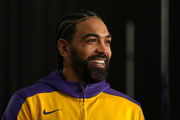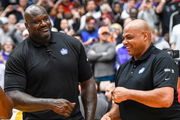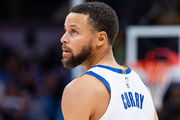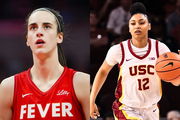
Imago
Carmelo Anthony for Knicks.

Imago
Carmelo Anthony for Knicks.
An organization running since 1946 and its arena dubbed ‘The Mecca‘ is bound to have more than a few great players in its history. Recently, Jalen Brunson’s heroics propelled the team to the ECF, and since then, the question raised was whether he was the best player in the organization’s history. If not at the top spot, some are okay with him being part of the all-time list, which includes former players like Patrick Ewing and Carmelo Anthony. The only potential issue for these two players is that they brought the chip to the Big Apple.
Watch What’s Trending Now!
So are there better players than them that won championships and dominated on the court? Let’s find out.
ADVERTISEMENT
Walt Frazier: The style and champion icon, unlike any other
Drafted fifth overall in 1967, Frazier spent 13 seasons in the NBA, and the Knicks retired his No. 10 jersey just two years after his retirement. As stated before, the team has won only championships in their history, both came when Walt Frazier was playing for the team from 1967 to 1977. In his rookie year, the name ‘Clyde’ became synonymous with his name, since he wore the Fedora like the character Clyde Barrow in the 1967 film Bonnie and Clyde.
Frazier averaged 19.3 points, 6.3 assists, 5.9 rebounds, and 2.0 steals. Those numbers got him on seven All-Star squads and six All-NBA teams. Frazier’s signature performance came during the 1970 and 1973 Finals—notably his 37-point, 7-assist masterpiece in Game 7 of the 1970 Eastern Conference Finals that set the stage for Reed’s heroics.
Top Stories
Lakers’ Gabe Vincent Dishes on LeBron James, Luka Doncic’s Sacrifices, Role on the Team and More (Exclusive)

Respect Pours In for Shaquille O’Neal, Charles Barkley After $200,000 Announcement

Calls Mount Against NBA Refs After Stephen Curry Wrongfully Punished vs Timberwolves

Arrest For Shaquille O’Neal’s Stolen Range Rover Made But More Bad News Awaits

Caitlin Clark, JuJu Watkins Announce Injury Update After Months of Battle

ADVERTISEMENT
Patrick Ewing’s domination was unlike any other
Ewing never won a title, but his pedigree is unquestioned. “We’ve had the Mikan era, the Russell era, the Kareem era … now we’ll have the Ewing era.” Pat O’Brien, a profound sportscaster with CBS Sports, read a quote from an unnamed NBA scouting director just before the 1985 NBA draft lottery. New rules meant a new lottery system, and it is still a talked-about moment, if the then-commissioner rigged the chances in favor of the Knicks. True or not, the Big Apple definitely benefited from the arrival of Patrick Ewing.
ADVERTISEMENT

Many reports expected him to be the No. 1 overall in 1985 and to be the face of their franchise. For 15 years, Ewing did that in New York, and the only thing missing is a championship. It was not due to any lack of effort; in fact, the Knicks reached the playoffs 13 times in the 15 seasons he played. In 2003, Ewing became just the 9th player whose number was retired by the Knicks. His #33 jersey is the last one to be retired by the franchise.
ADVERTISEMENT
Willis Reed, the captain who steered the ship despite injuries
“I always remember one thing that eventually, somewhere during my lifetime, I will not be a basketball player, 20 years down the road, 25 years down the road. I’ll be sitting somewhere at some lake fishing, and I would have to say to myself, ‘Boy, I wish I had played that night.’ I wouldn’t have let that happen. That was my moment.” Coming off a knee injury, Willis Reed’s decision to suit up for Game 7 of the 1970 Finals remains the franchise’s defining moment. Reed logged 45 minutes, poured in 18 points and grabbed 8 rebounds. He ignited an emotional spark that carried the Knicks to their first title. That night, he became the first and only player in NBA history to earn All-Star MVP, Regular Season MVP, and Finals MVP in the same season (1970)—a trifecta still unmatched.
Reed’s prime spanned just seven seasons at MSG, yet they became iconic. Before Fraizer, Reed’s number 19 was the first jersey retired by the New York Knicks. He coached both the Knicks and the New Jersey Nets after his playing career. Off the court, Reed’s stoic confidence and his famous quote about seizing “that moment” have become part of Knicks lore—an eternal reminder that true champions show up when it matters most
ADVERTISEMENT
Carmelo Anthony, A New York blood through and through
A Red Hook native, Melo spent 19 NBA seasons—six of them with the Knicks.. Before becoming a pro, he had already delivered the only title to the Syracuse program, one of the most prestigious college basketball programs, not just in New York, but in the USA. A proficient scorer on all levels of the game, he averaged 24.7 points, 3.2 assists, and 7.0 rebounds while shooting 36.9% from 3-point range.

Imago
Bildnummer: 12153216 Datum: 19.12.2012 Copyright: imago/UPI Photo
New York Knicks Carmelo Anthony reacts after hitting a 3-point shot in the second quarter against the Brooklyn Nets at Madison Square Garden in New York City on December 19, 2012. PUBLICATIONxINxGERxSUIxAUTxHUNxONLY NYP20121219104; Basketball USA NBA x0x xub 2012 quer premiumd
Image number 12153216 date 19 12 2012 Copyright imago UPI Photo New York Knicks Carmelo Anthony reacts After Hitting A 3 Point Shot in The Second Quarter Against The Brooklyn Nets AT Madison Square Garden in New York City ON December 19 2012 PUBLICATIONxINxGERxSUIxAUTxHUNxONLY Basketball USA NBA x0x xub 2012 horizontal premiumd
His personal milestones often get lost amid the Knicks’ playoff drought. Despite that, he remains one of the faithful in the eyes of the Knicks fans, especially the fans who fell out of love. Carmelo Anthony’s game brought hope, and if only matched with the championship, no doubt his jersey would be in the rafters currently. As stated earlier, it’s difficult to shoehorn 5 names when the history is as big and diverse as the New York team.
ADVERTISEMENT
Some honorable mentions include Bernard King and Dave DeBusschere, amongst others. King only played four seasons in MSG, but they were memorable ones. He won his scoring title in 1984-85, averaging 32.9 points per game. If you don’t know about DeBusschere, then Walt Frazier’s quotes will help you out. “I thought when he came to the Knicks, he was kind of in the twilight of his career. He was rejuvenated as a Knick.” Another important part of the team that won the two championships.
ADVERTISEMENT
Earl Monroe: The backcourt partner who ticked it all
“Earl could do things that other players wouldn’t even attempt to do. Some people said that what he was doing was showboating. And it wasn’t. What he was doing was just getting an advantage.” Legendary coach Pat Riley once said. The partner in crime of the Clyde, Earl Monroe, truly changed the game. Some even called him Magic before Magic, while Kareem Abdul-Jabbar had no hesitation in naming ‘Earl the Pearl’ the best player.
From 1971–74, Monroe teamed with Walt Frazier to form one of the league’s first true “showtime” backcourts. He averaged 16.2 points, 3.5 assists, and 2.6 rebounds in Knicks uniforms. His rookie-of-the-year explosiveness (a staggering 18.8 ppg on 46% shooting) morphed into a veteran’s craft. 258 playoff points in the 1973 title run alone, punctuated by his dazzling 51-point, 11-assist burst in Game 4 of the Eastern Conference Finals.
Despite persistent knee issues that later required crutches, Monroe’s flair earned him 4 All-Star nods, the 1973 NBA championship, and a spot on both the NBA 50th (1996) and 75th (2021) Anniversary Teams, hallmarks of a legacy cemented in the Hall of Fame (inducted 1990). A flashy guard who became a walking highlight reel at his peak, Monroe spent nearly 10 years in New York. Yet, Monroe didn’t make the top Knicks record books in almost any metric. But no one would deny his place as one of the highly influential players of the franchise’s history.
ADVERTISEMENT
ADVERTISEMENT
ADVERTISEMENT
ADVERTISEMENT

